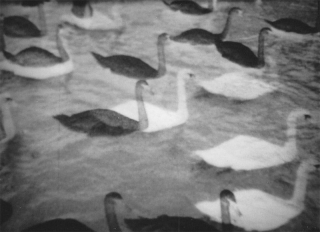Date: 1 November 2003 | Season: London Film Festival 2003 | Tags: London Film Festival
LIGHT TRACES
Saturday 1 November 2003, at 4pm
London National Film Theatre NFT3
Julie Murray, Untitled (Light), USA, 2002, 5 min
A night-time memorial to the World Trade Centre site and its ‘towers of light’.
Guy Sherwin, Animal Studies, UK, 1998-2003, 25 min
A series of meditations on nature and the animal kingdom, comprising both physical and metaphysical reflection. Each has the subtle, granular pulsing that makes it seem as though these could be the first rolls of film ever wrenched through a camera.
Karl Kels, Prince Hotel, Germany, 1987-2003, 8 min
A portrait of New York’s Bowery and its time-warn occupants. Though no longer solely a refuge for alcoholics and the lost, some of those characters remain, and their world is revered by Kels’ camera, displaying humour and a deep sense of camaraderie.
Jimmy Robert, Embers, UK, 2003, 7 min
Using the modest Super-8 gauge to film his immediate personal surroundings, Jimmy Robert has developed a profound personal style. Fleeting moments are combined in editing, evoking moods through the juxtaposition of images.
Nathaniel Dorsky, The Visitation, USA, 2002, 18 min
‘The Visitation is a gradual unfolding, an arrival so to speak. I felt the necessity to describe an occurrence, not one specifically of time and place, but one of revelation in one’s own psyche. The place of articulation is not so much in the realm of images as information, but in the response of the heart to the poignancy of the cuts.’
PROGRAMME NOTES
LIGHT TRACES
Saturday 1 November 2003, at 4pm
London National Film Theatre NFT3
UNTITLED (LIGHT)
Julie Murray, USA, 2002, colour, sound, 5 min
A moving reflection on September 11, Untitled (Light) finds beauty in minutiae, breaking down the skyward searchlights memorializing the fallen towers into a constellation of illuminated dust motes. —Onion City Film Festival, 2003
ANIMAL STUDIES
Guy Sherwin, UK 1998-2003, b/w, silent, 25 min
A variable set of perceptual studies on the inconsequential movements of animals. The films are made partly in the camera and partly in the printer, and most are derived from a single take. Fluctuations of light, geometry and time reveal what might be hidden in the photographic depths of the material. My filmic interest in animals is that they are unselfconscious, authentic, and don’t act. This is part of an ongoing series of films which developed out of the Short Film Series, and can be shown in any order or number, giving an openness of connection between images, ideas, thoughts, themes. —Guy Sherwin
PRINCE HOTEL
Karl Kels, Germany 1987-2003, b/w, silent, 8 min
In 1986 Kels received a fellowship that allowed him to study at Cooper Union in New York. During his stay there, Kels spent some six months at the Bowery in Lower Manhattan. He began hanging out with the less fortunate who eke out an existence in cheap hotels or on the street, and became friendly with many of them. In the lives of the mostly male alcoholics who survive on open camaraderie and cheap alcohol, he discovered a rich unstaged world, which he slowly started to film. Bowery / Fragment [the working title for Prince Hotel] is but a short fragment of what a final film on this subject could offer, yet it stands by itself and clearly bears the director’s marks. Against the background of a run-down Prince Hotel we see men who pass time together, deliberately portrayed by Kels’ clear eye for framing and detail, and yet whose acts and movements cannot be controlled. —Miryam Van Lier, Millennium Film Journal
EMBERS
Jimmy Robert, UK, 2003, colour, silent, 7 min
Using the modest super-8 gauge to film his immediate personal surroundings, Jimmy Robert has developed a profound personal style. Fleeting moments are combined in editing, evoking moods through the juxtaposition of images. —Mark Webber
THE VISITATION
Nathaniel Dorsky, USA, 2002, colour, silent, 18 min
The Visitation is a gradual unfolding, an arrival so to speak. I felt the necessity to describe an occurrence, not one specifically of time and place, but one of revelation in one’s own psyche. The place of articulation is not so much in the realm of images as information, but in the response of the heart to the poignancy of the cuts. —Nathaniel Dorsky
Back to top
